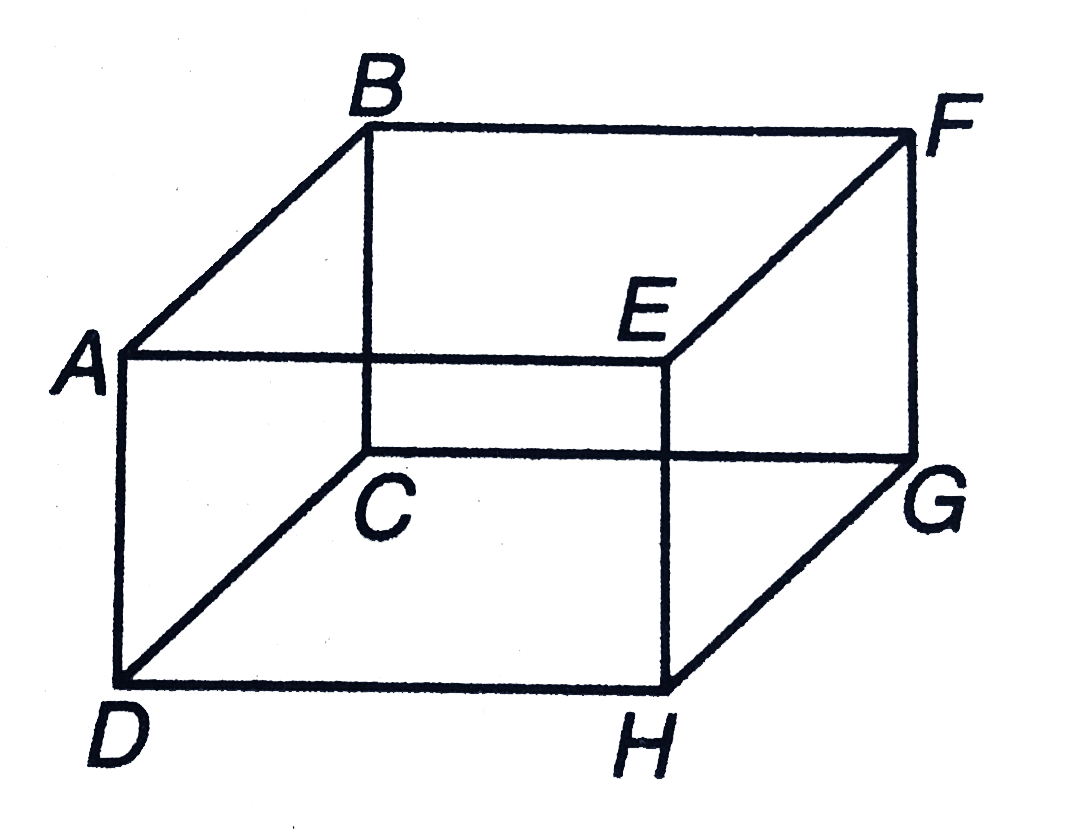A small spherically symmetrica charge q is placed at one vertex of a cube as shown. The flux through the faces ABCD, and HGEF are, respectively.
q24ε0,q24ε0
0,q8ε0
q8ε0,0
q24ε0,0
The correct Answer is:4
To solve the problem of finding the electric flux through the faces ABCD and HGEF of a cube with a charge q placed at one of its vertices, we can follow these steps:
Step 1: Understand the Geometry
The charge q is located at one vertex of the cube. The cube has 8 vertices, and since the charge is at one vertex, it will influence the flux through the faces that are adjacent to this vertex.
Step 2: Use Gauss's Law
According to Gauss's Law, the electric flux Φ through a closed surface is given by:
Φ=Qenclosedϵ0
where Qenclosed is the total charge enclosed by the surface and ϵ0 is the permittivity of free space.
Step 3: Determine the Enclosed Charge
Since the charge q is at the vertex of the cube, it is only partially enclosed by the cube. In fact, only 18 of the charge q is effectively enclosed by the cube because the cube can be thought of as being one of 8 identical cubes that could be formed around the charge at the vertex.
Thus, the enclosed charge Qenclosed for the cube is:
Qenclosed=q8
Step 4: Calculate the Total Flux Through the Cube
Using Gauss's Law, the total electric flux through the entire cube is:
Φtotal=Qenclosedϵ0=q/8ϵ0=q8ϵ0
Step 5: Distribute the Flux Among the Faces
The total flux through the cube will be distributed among the three faces that are adjacent to the vertex where the charge is located (faces ABCD, ABFE, and ADEF). Since the charge is symmetrically placed at the vertex, the flux through these three faces will be equal.
Thus, the flux through each of the three adjacent faces is:
Φface=Φtotal3=q/(8ϵ0)3=q24ϵ0
Step 6: Determine the Flux Through HGEF
The face HGEF is opposite to the vertex where the charge is located. Since there is no charge enclosed by this face, the electric flux through HGEF is:
ΦHGEF=0
Final Summary
- The flux through the face ABCD is q24ϵ0.
- The flux through the face HGEF is 0.
Final Answer
The flux through the faces ABCD and HGEF are, respectively:
q24ϵ0,0
The charge q is located at one vertex of the cube. The cube has 8 vertices, and since the charge is at one vertex, it will influence the flux through the faces that are adjacent to this vertex.
According to Gauss's Law, the electric flux Φ through a closed surface is given by:
Φ=Qenclosedϵ0
where Qenclosed is the total charge enclosed by the surface and ϵ0 is the permittivity of free space.
Since the charge q is at the vertex of the cube, it is only partially enclosed by the cube. In fact, only 18 of the charge q is effectively enclosed by the cube because the cube can be thought of as being one of 8 identical cubes that could be formed around the charge at the vertex.
Qenclosed=q8
Using Gauss's Law, the total electric flux through the entire cube is:
Φtotal=Qenclosedϵ0=q/8ϵ0=q8ϵ0
The total flux through the cube will be distributed among the three faces that are adjacent to the vertex where the charge is located (faces ABCD, ABFE, and ADEF). Since the charge is symmetrically placed at the vertex, the flux through these three faces will be equal.
Φface=Φtotal3=q/(8ϵ0)3=q24ϵ0
The face HGEF is opposite to the vertex where the charge is located. Since there is no charge enclosed by this face, the electric flux through HGEF is:
ΦHGEF=0
- The flux through the face ABCD is q24ϵ0.
- The flux through the face HGEF is 0.
The flux through the faces ABCD and HGEF are, respectively:
q24ϵ0,0
Topper's Solved these Questions
- ELECTROSTATIC POTENTIAL AND CAPACITANCE BOOK - AAKASH INSTITUTE ENGLISHCHAPTER - ELECTROSTATIC POTENTIAL AND CAPACITANCE EXERCISE - SECTION-C (OBJECTIVE TYPE QUESTIONS (More than one answer))
13 Videos
- ELECTROSTATIC POTENTIAL AND CAPACITANCE BOOK - AAKASH INSTITUTE ENGLISHCHAPTER - ELECTROSTATIC POTENTIAL AND CAPACITANCE EXERCISE - SECTION-D(COMPREHENSION-I)
2 Videos
- ELECTROSTATIC POTENTIAL AND CAPACITANCE BOOK - AAKASH INSTITUTE ENGLISHCHAPTER - ELECTROSTATIC POTENTIAL AND CAPACITANCE EXERCISE - SECTION-B (OBJECTIVE TYPE QUESTIONS (ONLY ONE ANSWER) )
1 Videos
- ELECTROMAGNETIC WAVESBOOK - AAKASH INSTITUTE ENGLISHCHAPTER - ELECTROMAGNETIC WAVESEXERCISE - ASSIGNMENT SECTION - D Assertion-Reason Type Questions
25 Videos
- GRAVITATION BOOK - AAKASH INSTITUTE ENGLISHCHAPTER - GRAVITATION EXERCISE - ASSIGNMENT SECTION - D (ASSERTION-REASON TYPE QUESTIONS)
15 Videos
Similar Questions
A charge q is located at the centre of a cube. The electric flux through any face is
View SolutionA charge q is located at the centre of a cube. The electric flux through any face is
View SolutionA charge q is placed at the centre of a cube. What is the electric flux passing through the cube?
View SolutionIf a point charge q is placed at one corner of a cube, what is the flux linked with the cube?
View SolutionA charge Q is situated at the centre of a cube. The electric flux through one of the faces of the cube is
View SolutionA point charge Q is placed at the corner of a square of side a. Find the flux through the square.
View SolutionCharge of 2 C is placed at the centre of a cube. What is the electric flux passing through one face ?
View SolutionA charge q is placed at the centre of a cube of side l what is the electric flux passing through two opposite faces of the cube ?
View SolutionA charge q is placed at the centre of a cube of side l what is the electric flux passing through two opposite faces of the cube ?
View SolutionA charge q is placed at point D of the cube. Find the electric flux passing through the EFGH and face AEHD.

View Solution
